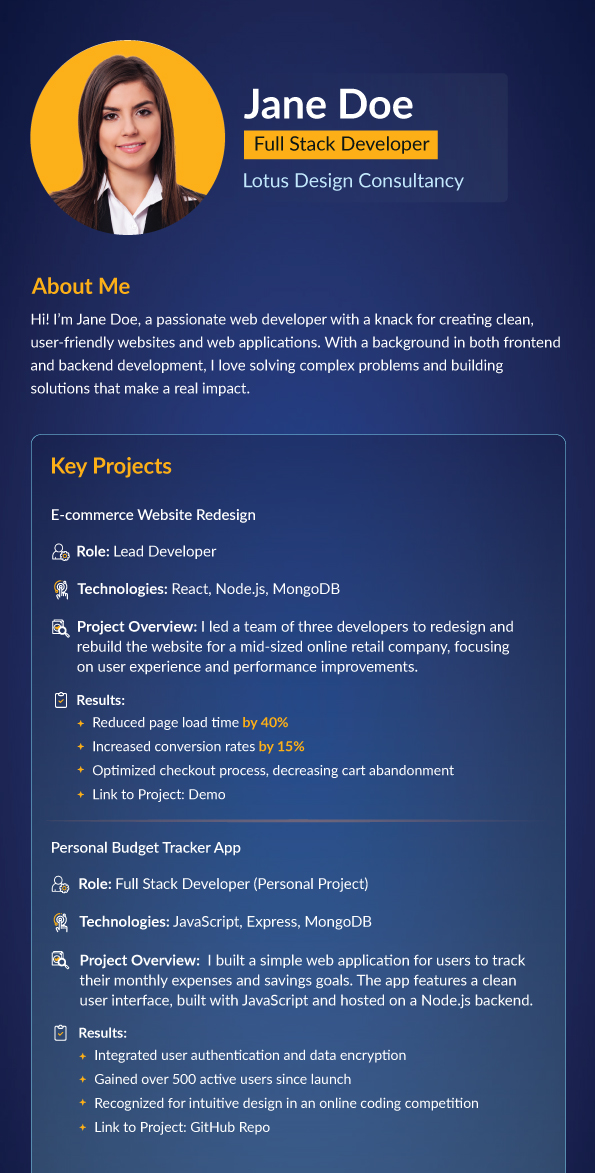Crafting a Job Winning Portfolio As Fresher: What to Include for Every Stage of Your Career
In today’s competitive job market, a strong portfolio is more than just a collection of work—it's your personal brand in action. Whether you're stepping into the professional world or aiming to level up, your portfolio showcases your skills, achievements, and potential. But what makes a portfolio truly stand out? Let's dive into the key elements that will set you apart, no matter where you are in your career.
Starting Out: Building Your First Portfolio
If you're just beginning to craft your portfolio, you might feel you don’t have enough experience to fill it. That couldn't be further from the truth. Your portfolio should reflect your learning journey, creativity, and ability to adapt.
Here’s what to include:
- Academic Projects: Even school projects offer a glimpse into problem-solving skills and technical abilities. Showcase projects that highlight your strongest areas. Whether it’s a capstone project, a group assignment, or a coding challenge, describe your role, the tools you used, and the results you achieved. Include screenshots, code snippets, or even short videos of your projects in action to make them interactive and engaging.
- Internships and Volunteering: Hands-on experience is invaluable. If you've completed an internship or volunteer work, this is your chance to shine. Explain your responsibilities and, most importantly, the impact you made. If you improved a process, helped launch a campaign, or contributed to a product development cycle, include these accomplishments and the skills you developed in the process.
- Personal Projects and Extracurriculars: Don’t limit yourself to formal work. Have you built a website for a friend or participated in a hackathon? Side projects can reveal your passion and dedication to continuous learning. Whether you’re coding a game, designing a website, or building an app, these extracurricular activities show initiative and creativity. Be sure to explain your motivation behind these projects and what you learned along the way.
- Certifications and Skills: Certifications can give you a competitive edge, especially in a crowded market. Include any certifications you've earned in relevant areas—whether it's a programming language, software development, or even soft skills like project management. Highlight specific skills that are in demand for the field you're targeting, and mention how you've applied them in your projects.
Advancing Your Career: A Portfolio Refresh
When you’re looking to advance your career, your portfolio should go beyond listing projects—it should demonstrate expertise, leadership, and results.
Here’s how to build or refresh your portfolio:
- Signature Projects: Focus on the projects that define your career. Highlight 3-5 key projects where you made a significant impact. Whether it’s improving a company’s ROI, leading a development team, or solving complex challenges, these should be well-documented. Include case studies, metrics, and outcomes to provide concrete evidence of your success. Be sure to explain the problems you solved, the approach you took, and the final results.
- Testimonials and Recommendations: Nothing speaks louder than a recommendation from someone you’ve worked with. Include quotes or endorsements from clients, colleagues, or supervisors that highlight your work ethic, skills, and contributions. If possible, link these testimonials to the projects in your portfolio to give them context.
- Leadership and Teamwork: At this stage, it’s not just about what you’ve done but how you’ve done it. Show that you’re not just a solo player but someone who thrives in a team environment. Highlight experiences where you led teams, collaborated across departments, or mentored others. Include examples that illustrate your communication and leadership style.
- Published Work and Speaking Engagements: If you’ve written articles, given presentations, or spoken at conferences, this can add tremendous value to your portfolio. Include links to your work, videos, or even slides from presentations. This demonstrates your thought leadership and expertise in the field, making you stand out to employers and clients.
- Continuous Learning and Certifications: Learning never stops, especially in tech. Make sure to include any recent certifications, courses, or workshops that demonstrate your commitment to staying ahead of industry trends. Whether you’ve mastered a new programming language or upskilled in project management, this section shows your growth mindset and adaptability.
No matter where you are in your journey, these tips apply universally:
- Tailor Your Portfolio to Your Audience: Think about the job or industry you're targeting and customize your portfolio accordingly. Highlight the skills and experiences that will resonate most with prospective employers.
- Keep It Visual: No one wants to read walls of text. Break up your content with images, videos, infographics, and interactive elements that draw the viewer in and make your work more engaging.
- Show Your Personality: Your portfolio isn’t just about your work; it’s also about who you are as a professional. Use your portfolio to communicate your unique style, approach, and enthusiasm for your field.
- Regularly Update Your Portfolio: Your portfolio is a living document. As you gain more experience, don’t forget to update it with new projects, skills, and achievements. This shows potential employers that you’re constantly evolving.

Conclusion
A well-crafted portfolio is your ticket to standing out in a crowded field. Whether you’re starting out or established in your field, the key is to keep your portfolio fresh, engaging, and reflective of your journey. It's not just about showcasing your work—it's about telling the story of your growth, leadership, and expertise. So, what are you waiting for? Start building or updating your portfolio today, and let your work speak for itself.




